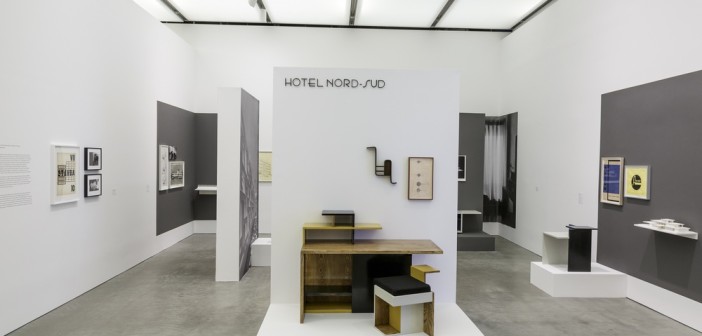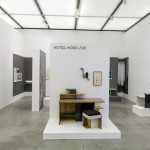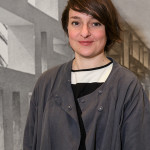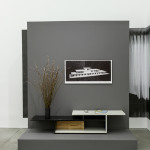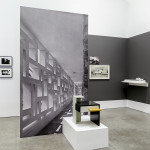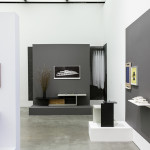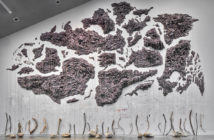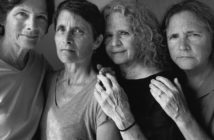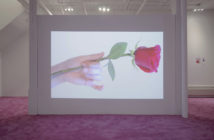At first glance, Katarina Burin's installation in this year's Foster Prize looks out of place within the ICA's sterile, white gallery space.Hotel Nord-Sud 1932-34: Design and Correspondence (2013) is centered around Petra Andrejova-Molnár, a female Czechoslovakian architect active during the European inter-war period, and showcases her crowning architectural achievement: the Hotel Nord-Sud, destroyed in World War II. Burin presents Andrejova-Molnár's sketches of the hotel, as well as artifacts from it, alongside archival materials and photographs of the architect and her contemporaries. Situated next to Sarah Bapst's intricate and meticulous deconstructed air conditioner and opposite Mark Cooper's sprawling, vibrant Yu Yu Tangerine, Burin's work is quiet and meditative. It considers a history of modernism interpreted against the tragedy and cataclysmic change that shaped the Euro-American twentieth century. This history is articulated by generations of scholars, each marked by their own historical context. Hotel Nord-Sud reminds us that our experience of the past is always informed by our present, and that only through careful looking and consideration do we know the biases of our own context. For through closer inspection, we see that Burin presents Andrejova-Molnár, her life and her iconic Hotel Nord-Sud, as a sort of historical fact-based fiction. Andrejova-Molnár is purely Burin's creation, and only lives within our imaginations.
"Part avatar, part object of wishful thinking "Andrejova-Molnár" allows the artist to experiment with a wide range of media and different versions of authorship, while incidentally "adding" to the woefully small ranks of female architects," writes Helen Molesworth, who curated the prize this year, in the show's small catalogue. And in Hotel Nord-Sud, Burin is encyclopedic in her choice of media, exploring drawing, sculpture, photography and furniture. The hotel's distinctive sign is at the entrance to the installation, buoyed by a desk and decorative objects that Andrejova-Molnár designed for it. These "artifacts" are recognizably International Style Modern. This museum-like display is flanked by Andrejova-Molnár's designs for the hotel, as well as more objects and photographs from within in it. Also presented are photographs of Andrejova-Molnár and friends. All are interpreted for the viewer with wall texts that explain the meaning and purpose of each item presented to us. "In the shifting, political arena of rediscovered boundaries, these architects were emboldened by the utopian spirit of the age and embraced an architecture that championed modernity, efficiency, functionality and a commitment to human progress and innovation," reads one, titled "Idealism and Interwar Internationalism in Eastern Europe: P.A. and Her Contemporaries." The European architects who Burin imagines that Andrejova-Molnár associated with were euphorically optimistic in the years just after World War I, which irreversibly transformed Europe from quasi-medieval to modern. These architects trusted that their dawning new age could be only good, and believed that design should uplift and inspire the people. In her installation, Burin echoes this Utopian belief in design and art by including objects such as chairs, vases and magazines alongside architectural models and large archival prints of inside the Hotel Nord-Sud. In creating each of these, Burin inhabits an idealized role of the interwar women architects who never were and the mythic 'New Woman,' which underscores modernism's limitations and failures. "Furniture and design gave me a way to connect with the history and politics of that time, especially through the rhetoric of their depiction," says Burin in her interview with Molesworth, also published in the catalogue. "At first I made drawings from photographs, but then I started making up my own design language mimicking the styles of architectural drawing."
Photographs, papers and objects remain to tell the story of a person, place or period, but they are often fractured and framed by historical interpretation. In her portrayal of a person who never really lived via a portrait of a period, Burin occupies the Modern moment by contouring it through the limits of contemporary historical and museological methodologies. History is fluid, constantly shifting as the contemporary moment progresses, just as personal, political and national boundaries morphed during the interwar period. In presenting Anrejova-Molnár and her Hotel Nord-Sud, Burin laments what might have been, what never was, and what we'll never know about our histories by demonstrating how perception embodies the past.
Every two years the ICA holds the James and Audrey Foster Prize by creating a short list of Boston artists of "exceptional promise" and establishing a panel of professionals to assess those artists. All four of the short-listed artists exhibit at the ICA, and one is announced as the James and Audrey Foster Prize winner.
This year’s short list is Sarah Bapst, Katarina Burin, Mark Cooper, and Luther Price.
This year’s jury is Mark Dion, artist; Paul Ha, director of MIT List Visual Arts Center, Cambridge, MA; and Ali Subotnick, curator at the Hammer Museum, Los Angeles, CA.
Over the next four days we will be running a review for each of the artists on display. They will be in alphabetical order.
We here at Big Red & Shiny congratulate Katarina Burin for winning this year’s James and Audrey Foster Prize.
- Katarina Burin, HOTEL NORD—SUD 1932—34: Design and Correspondence, 2013, Drawings, silver gelatin prints, architectural models, objects, furniture, vinyl letters, wall paint, digital images. Dimensions variable. Courtesy the artist. Photo: John Kennard.
- Katarina Burin. Courtesy of the ICA, Boston.
- Katarina Burin, HOTEL NORD—SUD 1932—34: Design and Correspondence, 2013, Installation view. Drawings, silver gelatin prints, architectural models, objects, furniture, vinyl letters, wall paint, digital images. Dimensions variable. Courtesy the artist. Photo: John Kennard.
- Katarina Burin, HOTEL NORD—SUD 1932—34: Design and Correspondence, 2013, Installation view. Drawings, silver gelatin prints, architectural models, objects, furniture, vinyl letters, wall paint, digital images. Dimensions variable. Courtesy the artist. Photo: John Kennard.
- Katarina Burin, HOTEL NORD—SUD 1932—34: Design and Correspondence, 2013, Installation view. Drawings, silver gelatin prints, architectural models, objects, furniture, vinyl letters, wall paint, digital images. Dimensions variable. Courtesy the artist. Photo: John Kennard.

